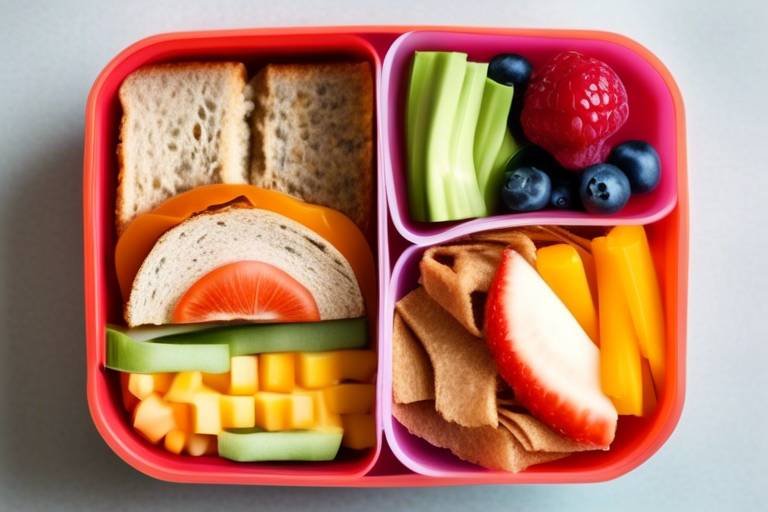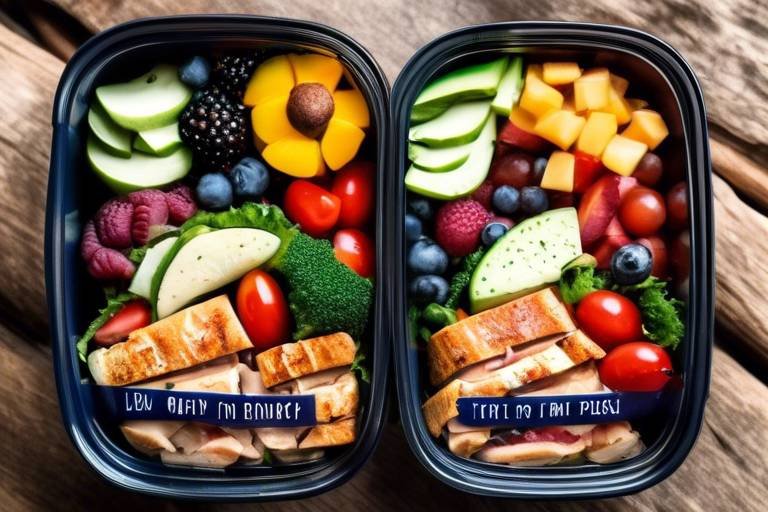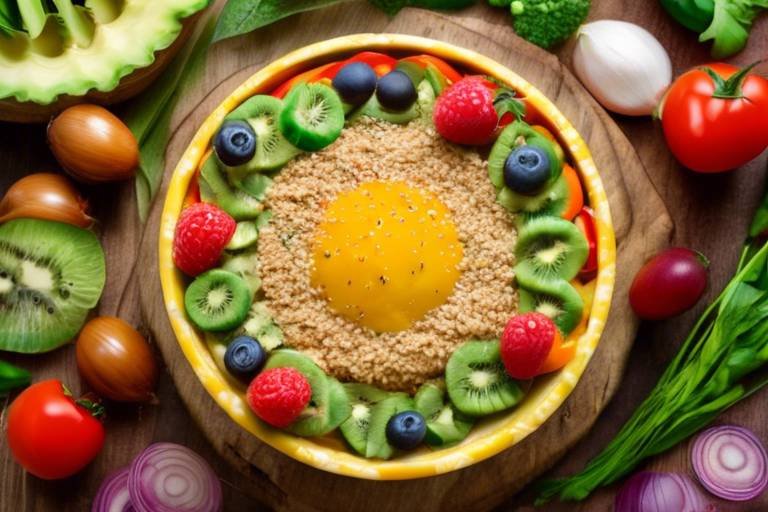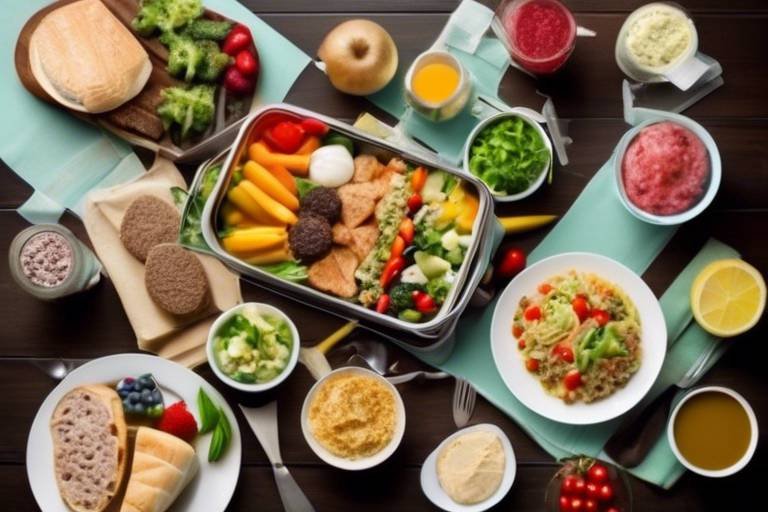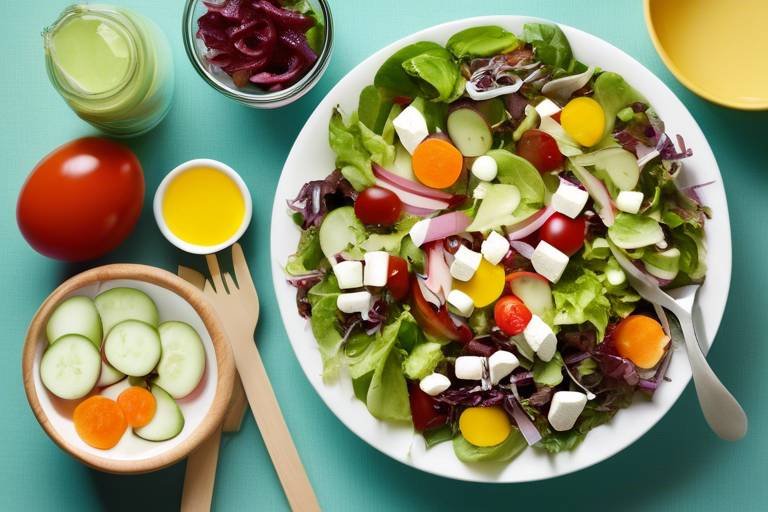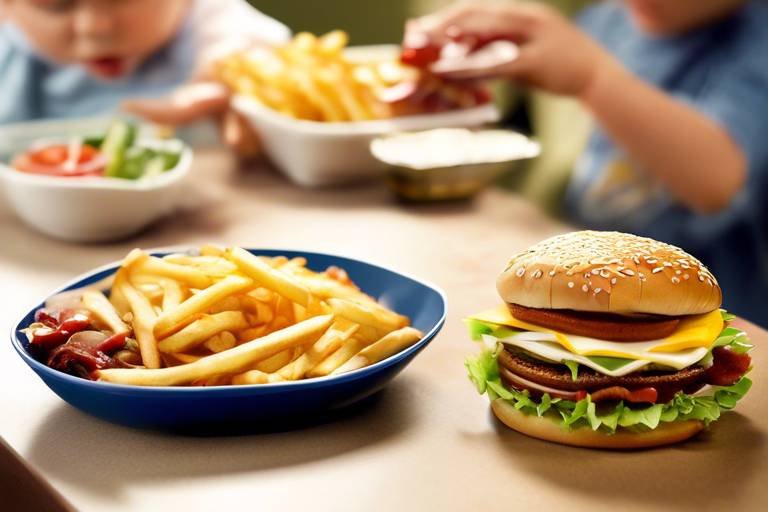Transforming Fast Food Favorites into Healthy Family Meals
In today’s fast-paced world, the allure of fast food is undeniable. It’s quick, it’s tasty, and let’s face it, sometimes it just hits the spot! But what if we told you that you could enjoy all your favorite fast food dishes without the guilt? Yes, you heard that right! This article is your guide to transforming those beloved fast food favorites into healthy, nutritious meals that your entire family will love. Imagine biting into a juicy burger or crispy fries, but knowing that each ingredient is wholesome and good for you. Sounds amazing, right? Let’s dive into this culinary journey where we’ll explore how to recreate these dishes at home, making them not only delicious but also packed with nutrients!
Fast food cravings often stem from the convenience and bold flavors that these meals offer. Have you ever wondered why you can’t resist that cheesy slice of pizza or those golden, crispy chicken nuggets? It’s all about the brain’s reward system. When we consume foods high in fats, sugars, and salts, our brain releases feel-good chemicals like dopamine, making us crave more. But fear not! We’ll delve into the psychology behind these cravings and show you how to satisfy them with healthier homemade alternatives. Imagine being able to whip up a delicious veggie-packed pizza or baked chicken nuggets that not only taste amazing but also nourish your body. Your family will be begging for seconds!
Now that we’ve established the cravings, let’s talk about the foundation of transforming fast food into healthy meals: choosing the right ingredients. The key here is to select wholesome, nutrient-dense options that enhance flavor without compromising health. Think of it as building a house; if you use strong, quality materials, your house will stand firm. Similarly, using fresh, natural ingredients will make your meals not only healthier but also tastier. For instance, instead of using white bread for your sandwiches, opt for whole grain or sprouted bread. It’s a simple switch that adds fiber and nutrients!
One of the biggest culprits in fast food is the use of processed ingredients. But don’t worry, we can easily replace these with natural alternatives! For example, instead of using store-bought sauces loaded with preservatives, try making your own at home. A simple blend of fresh tomatoes, herbs, and spices can create a delicious marinara sauce that’s free from additives. Not only will this improve the nutritional value of your meals, but it will also enhance the flavor, making your family meals more enjoyable. Your taste buds will thank you!
Incorporating whole grains into your meals is another fantastic way to boost fiber and nutrients. Whole grains are packed with vitamins, minerals, and antioxidants that refined grains simply lack. Consider substituting white rice with quinoa or brown rice in your favorite dishes. Not only do these options provide a nutty flavor, but they also keep you feeling fuller for longer. It’s like giving your body a nutritious hug!
Adding fresh vegetables is an excellent way to increase the nutritional profile of fast food favorites. Think of vegetables as the vibrant colors on your plate that not only make your meal appealing but also provide essential vitamins and minerals. You can sneak in veggies by adding spinach to your smoothies, bell peppers to your tacos, or zucchini to your pasta dishes. Get creative! The more colorful your plate, the more nutrients you’re likely consuming.
Seasonings can elevate the taste of healthy meals, making them just as delicious as their fast food counterparts. Instead of relying on unhealthy additives, explore the world of herbs and spices. Basil, oregano, garlic, and paprika can transform a simple dish into a flavor explosion! You’ll find that with the right seasonings, you can replicate the flavors of fast food while keeping your meals healthy.
The way you cook can significantly impact the healthiness of your meals. For example, grilling is a healthier alternative to frying, providing a delicious smoky flavor without excess oil. When you grill your meats or veggies, you allow the natural flavors to shine through while reducing fat content. Plus, it’s a great way to enjoy outdoor cooking with the family! Alternatively, baking can also be a fantastic method to prepare meals with less fat. Imagine crispy, baked sweet potato fries that are just as satisfying as the fried version but without the guilt!
Grilling not only enhances the flavor but also helps in reducing calories. Here are some tips for perfect grilling:
- Preheat your grill to ensure even cooking.
- Marinate your proteins for added flavor.
- Use a grill basket for veggies to prevent them from falling through the grates.
With these tips, you’ll be able to create delicious grilled meals that the whole family will love!
Baking is another technique that allows you to enjoy your favorite dishes with fewer calories. By using whole ingredients and minimal oil, you can create crispy, flavorful dishes that mimic fried favorites. Think baked chicken tenders coated in whole grain breadcrumbs or oven-roasted veggies seasoned with herbs. These options are not only tasty but also provide a healthier alternative that everyone can enjoy!
A balanced meal incorporates proteins, carbohydrates, and fats. This section will guide you on how to create well-rounded meals that satisfy the whole family while keeping health in mind. It’s important to remember that balance is key. For instance, a meal could consist of grilled chicken (protein), quinoa (carbohydrate), and a colorful salad (fiber and vitamins). By combining these elements, you ensure that everyone leaves the table feeling satisfied and nourished.
Understanding portion sizes is essential for maintaining a healthy diet. We’ll provide practical tips on how to serve appropriate portions without sacrificing taste or satisfaction. One effective strategy is to use smaller plates; this can trick your brain into thinking you’re eating more. Additionally, serving family-style encourages everyone to take what they want while being mindful of their portions.
Getting the whole family involved in meal preparation can make healthy eating more enjoyable. Discover fun ways to engage everyone in the kitchen, fostering a love for nutritious food. Whether it’s chopping veggies, mixing ingredients, or setting the table, involving your family in the cooking process creates a sense of togetherness and excitement. Plus, it’s a great way to teach kids about healthy eating habits!
Q: Can I really make fast food healthier at home?
A: Absolutely! By choosing the right ingredients and cooking methods, you can recreate your favorite fast food dishes in a healthier way.
Q: What are some easy substitutions for fast food ingredients?
A: Some easy substitutions include using whole grain bread instead of white bread, homemade sauces instead of store-bought, and baking instead of frying.
Q: How can I get my kids to eat more vegetables?
A: Get creative! Incorporate veggies into smoothies, use colorful presentations, or involve them in cooking to make it fun.

Understanding Fast Food Cravings
Fast food cravings are something most of us can relate to. Imagine this: it's a busy weekday evening, and the thought of whipping up a homemade meal feels overwhelming. Suddenly, the allure of a greasy burger or crispy fries calls out to you like a siren's song. But why do we crave these quick and convenient options? The truth is, our cravings often stem from a combination of psychological and physiological factors. Fast food is designed to be hyper-palatable, meaning it hits all the right notes of flavor, texture, and aroma, making it hard to resist.
One major reason we find ourselves drawn to fast food is the **convenience** it offers. In our fast-paced lives, grabbing a quick bite can feel like a lifesaver. But convenience doesn't have to come at the expense of health. By understanding what drives our cravings, we can find ways to satisfy them with healthier homemade alternatives. Think of it as a culinary adventure where you can recreate your favorite fast food dishes using wholesome ingredients that your family will love.
Moreover, our bodies can develop a dependency on the sugar, salt, and fat typically found in fast food. These ingredients trigger the release of dopamine, the feel-good hormone, creating a cycle of cravings that can be hard to break. But here's the good news: you can replicate those flavors and textures at home without the unhealthy additives! By experimenting with spices, herbs, and fresh ingredients, you can create meals that not only satisfy your cravings but also nourish your body.
So, how can we tackle these cravings head-on? Here are a few strategies:
- Mindful Eating: Pay attention to what you eat and how it makes you feel. This can help you recognize true hunger versus cravings.
- Healthier Alternatives: Swap out your favorite fast food items for homemade versions using fresh, whole ingredients.
- Plan Ahead: Prepare meals in advance to eliminate the temptation of fast food when you're short on time.
By understanding the psychology behind fast food cravings, you can take control of your eating habits and transform your approach to meals. It's not about depriving yourself; it's about finding balance and making choices that satisfy your cravings while promoting health. The journey to healthier eating can be both exciting and delicious, so let’s dive deeper into how we can choose healthier ingredients for our favorite fast food dishes!

Choosing Healthier Ingredients
When it comes to transforming your favorite fast food dishes into healthier family meals, choosing the right ingredients is absolutely essential. It’s like building a house; if you start with strong materials, your structure will stand tall and proud. In the same way, selecting wholesome, nutrient-dense ingredients ensures that your meals not only taste amazing but also nourish your body. So, how do we go about this? Let’s dive into the world of ingredients and discover how to make smart choices that elevate your cooking.
First and foremost, think about the quality of your ingredients. Opting for fresh, organic produce can make a world of difference. Not only do they pack more flavor, but they also come loaded with vitamins and minerals that processed foods often lack. When you’re at the grocery store, try to fill your cart with colorful fruits and vegetables. The more colors you have, the more nutrients you’re likely to get. For example, consider adding vibrant bell peppers, deep green spinach, and rich red tomatoes to your shopping list.
Next, let’s talk about proteins. Fast food often relies on processed meats, which can be high in sodium and unhealthy fats. Instead, look for lean protein sources such as grilled chicken, turkey, or even plant-based options like beans and lentils. Not only do these alternatives provide essential nutrients, but they also help to keep your meals satisfying and filling. For instance, swapping out a greasy burger for a grilled chicken sandwich can significantly reduce calories without sacrificing flavor.
Now, what about those delicious sauces and dressings that often accompany fast food? Typically, these are loaded with sugar and preservatives. A great way to avoid this is by making your own sauces at home. You can easily whip up a healthier version of your favorite dressing by using simple ingredients like olive oil, vinegar, and fresh herbs. This not only keeps your meals light but also allows you to control the flavors and ingredients. Imagine drizzling a homemade garlic vinaigrette over a fresh salad instead of a heavy, store-bought dressing!
Whole grains are another important component to consider. Fast food often uses refined grains, which can spike your blood sugar and leave you feeling hungry shortly after. By choosing whole grain alternatives, you’re not only adding fiber to your meals but also enhancing their nutritional value. Think about swapping white bread for whole grain buns or using brown rice instead of white rice. You’ll find that these options are just as satisfying and can add a delightful texture to your dishes.
Finally, don’t underestimate the power of herbs and spices. They can transform any meal into a flavor explosion without the need for unhealthy additives. Instead of relying on salt or sugar to enhance taste, experiment with fresh herbs like basil, cilantro, or parsley. You can also use spices such as paprika, cumin, or garlic powder to add depth and excitement to your meals. It’s amazing how a sprinkle of the right seasoning can elevate a simple dish to gourmet status!
In conclusion, choosing healthier ingredients is all about making informed decisions that prioritize nutrition without sacrificing flavor. By focusing on fresh produce, lean proteins, whole grains, and flavorful herbs, you can create meals that your family will love and that will nourish their bodies. Remember, it’s a journey, and every small change you make in your cooking can lead to a healthier lifestyle.
- How can I make fast food healthier at home?
Start by using fresh ingredients, opting for lean proteins, and incorporating whole grains. Experiment with homemade sauces and seasonings to enhance flavor without the unhealthy additives.
- What are some easy substitutions for fast food ingredients?
Consider swapping refined grains for whole grains, using grilled proteins instead of fried, and adding fresh vegetables to your meals for extra nutrition.
- How can I get my family involved in meal prep?
Make cooking a fun family activity! Assign tasks based on age, such as washing vegetables, mixing ingredients, or setting the table. This not only makes meal prep enjoyable but also encourages a love for healthy eating.

Substituting Processed Ingredients
When it comes to transforming your favorite fast food dishes into healthier alternatives, one of the most impactful changes you can make is in the ingredients you choose. Fast food is notorious for its heavy reliance on processed ingredients, which often come packed with preservatives, unhealthy fats, and excessive sodium. But fear not! By substituting these processed ingredients with natural alternatives, you can elevate both the nutritional value and the flavor of your meals. Imagine swapping out that greasy burger patty for a lean turkey or black bean patty—suddenly, you have a dish that’s not only delicious but also packed with protein and fiber.
For instance, consider the common fast food staple: the French fry. Instead of deep-frying potatoes in unhealthy oils, why not try baking or air-frying them? This simple change can significantly reduce the calorie count while still delivering that satisfying crunch. You can also experiment with sweet potatoes, which offer a plethora of vitamins and minerals, making them a fantastic alternative. By using fresh herbs and spices, you can replicate the flavor profiles of those processed seasonings that fast food chains rely on, without the added chemicals and sodium.
Another great substitution involves sauces and condiments. Many fast food items are drenched in sugary or creamy sauces that can derail your healthy meal plans. Instead, opt for homemade versions using wholesome ingredients. For example, a simple mix of Greek yogurt, lemon juice, and fresh herbs can create a zesty and creamy dressing that’s far healthier than store-bought ranch. By taking the time to prepare your own sauces, you can control the ingredients and tailor the flavors to your family’s preferences.
To help you visualize some of these substitutions, here's a quick comparison table:
| Processed Ingredient | Healthier Substitute |
|---|---|
| Regular ground beef | Lean turkey or black bean patty |
| White bread | Whole grain or sprouted bread |
| French fries | Baked sweet potato fries |
| Store-bought sauces | Homemade yogurt-based sauces |
By making these simple substitutions, not only do you enhance the nutritional profile of your meals, but you also embark on a culinary adventure that can reignite your love for cooking. Plus, involving your family in these changes can be a fun way to teach them about healthier eating habits. So, the next time a fast food craving hits, remember that with a few clever swaps, you can enjoy all the flavors you love without compromising on health!
Q: Can I still enjoy my favorite fast food flavors while making healthier choices?
A: Absolutely! By using fresh herbs, spices, and natural ingredients, you can replicate those beloved flavors without the unhealthy additives.
Q: How can I make my kids more interested in healthy cooking?
A: Involve them in the kitchen! Let them help with meal prep, choose ingredients, and even experiment with flavors. Making cooking a fun activity can spark their interest in healthier foods.
Q: Are homemade versions of fast food really healthier?
A: Yes! When you make food at home, you control the ingredients and can avoid unhealthy additives, making it easier to create nutritious meals.

Opting for Whole Grains
When it comes to transforming our favorite fast food dishes into healthier family meals, one of the most significant changes we can make is opting for whole grains. You might be wondering, "What’s the big deal about whole grains?" Well, let me tell you, they pack a nutritional punch that refined grains simply can't compete with. Whole grains are unrefined and contain all parts of the grain—the bran, germ, and endosperm—making them rich in fiber, vitamins, and minerals. This not only helps in maintaining a healthy digestive system but also keeps you feeling fuller for longer, reducing those pesky snack cravings.
Incorporating whole grains into your meals can be as simple as swapping out white rice for brown rice or choosing whole grain bread instead of white bread. The flavor and texture of these grains can elevate your meals, adding a nutty taste that complements your favorite dishes beautifully. For instance, imagine a delicious burger made with a whole grain bun that adds a delightful crunch and a boost of nutrients. It’s a small change that can make a big difference!
Here are some fantastic whole grain options you can consider:
- Quinoa: A complete protein that's perfect for salads or as a side dish.
- Brown Rice: A great substitute for white rice, offering more fiber and nutrients.
- Oats: Not just for breakfast! Use them in meatloaf or as a binder in veggie burgers.
- Whole Wheat Pasta: A delicious alternative that pairs well with your favorite sauces.
- Barley: Adds a chewy texture to soups and stews.
By making these substitutions, you’re not just enhancing the nutritional value of your meals; you’re also introducing your family to a variety of textures and flavors that they might not have experienced before. Plus, whole grains are incredibly versatile. You can use them in salads, as sides, or even as the main ingredient in a hearty dish. Think of a savory quinoa bowl topped with grilled chicken and fresh veggies—sounds delicious, right?
As you embark on this journey to healthier eating, keep in mind that the transition to whole grains doesn’t have to be abrupt. You can gradually incorporate them into your meals. Start by mixing half white rice with half brown rice or using whole grain pasta in your favorite spaghetti recipe. Before you know it, your family will be enjoying the benefits of whole grains without even realizing it!
In summary, opting for whole grains is a simple yet effective way to enhance the healthiness of your meals. Not only do they provide essential nutrients, but they also offer a delightful flavor that can make your family meals more enjoyable. So, why not give it a try? Your taste buds and your body will thank you!
1. What are whole grains?
Whole grains are grains that contain all parts of the grain kernel, including the bran, germ, and endosperm. Examples include brown rice, quinoa, barley, and whole wheat.
2. How can I incorporate whole grains into my diet?
You can start by replacing refined grains with whole grains in your meals. Try using whole grain bread, pasta, and rice, and experiment with grains like quinoa and barley in salads and side dishes.
3. Are whole grains better for weight management?
Yes, whole grains are higher in fiber and nutrients, which can help you feel fuller for longer, potentially reducing overall calorie intake and aiding in weight management.
4. Can I still enjoy my favorite fast food dishes with whole grains?
Absolutely! You can recreate your favorite fast food dishes by using whole grain ingredients, making them healthier while still delicious.

Incorporating Fresh Vegetables
When it comes to transforming your favorite fast food dishes into healthier family meals, fresh vegetables are your best friends. Not only do they add a burst of color and flavor to your plate, but they also pack a serious nutritional punch. Imagine biting into a juicy burger, but instead of just lettuce, you’ve layered it with vibrant slices of bell peppers, crunchy cucumbers, and ripe tomatoes. The crunch and freshness of these veggies can elevate your meal from ordinary to extraordinary!
One of the most delightful aspects of incorporating fresh vegetables is the versatility they offer. You can sneak them into just about any dish. For example, if you’re making a homemade pizza, why not top it with a medley of vegetables like spinach, mushrooms, and red onions? Not only will it taste amazing, but you’ll also be adding fiber, vitamins, and minerals that are often missing in traditional fast food. Plus, the kids will love the colorful presentation!
Here are a few creative ways to integrate fresh vegetables into your meals:
- Mix into Sauces: Puree vegetables like carrots or zucchini into your pasta sauces. They’ll blend in seamlessly, adding nutrients without altering the flavor.
- Stuffed Options: Use vegetables like bell peppers or zucchini as vessels for your favorite fillings. Stuff them with lean proteins and whole grains for a satisfying meal.
- Salads as Sides: Instead of fries, serve a side salad loaded with various vegetables. This simple swap can drastically reduce calories while boosting your intake of essential nutrients.
Another fun idea is to create a vegetable bar at home! Set out an array of chopped fresh veggies and let your family build their own creations. This not only encourages creativity but also makes healthy eating a fun activity. From colorful carrot sticks to crunchy snap peas, the options are endless!
Incorporating fresh vegetables into your meals doesn’t have to be a chore. Think of it as an opportunity to explore new flavors and textures. When you make it a habit to include a variety of vegetables in your cooking, you’ll find that not only do your meals become more nutritious, but they also become a lot more exciting. So, next time you’re craving that fast food fix, remember that a little creativity with fresh veggies can turn your home-cooked meal into a feast that the whole family will love!

Exploring Flavorful Seasonings
When it comes to transforming your favorite fast food dishes into healthier meals, one of the most important aspects to consider is the use of seasonings. The right combination of herbs and spices can elevate the flavor profile of your meals, making them just as satisfying as their fast food counterparts—without the unhealthy additives. Think of seasonings as the magic dust that brings your dishes to life, turning a simple chicken breast into a zesty delight or a bland vegetable medley into a vibrant feast.
So, how do you harness the power of seasonings in your cooking? Start by exploring a variety of herbs and spices that not only enhance flavor but also offer health benefits. For instance, garlic is not only a flavor powerhouse but also known for its immune-boosting properties. Turmeric, with its warm, earthy flavor, contains curcumin, a compound celebrated for its anti-inflammatory effects. By integrating these into your meals, you can enjoy a culinary experience that’s both delicious and nutritious.
To make things even easier, consider creating your own seasoning blends. This not only allows you to customize flavors to your liking but also helps you avoid the hidden sugars and sodium often found in pre-packaged mixes. For example, a simple blend of oregano, cumin, and paprika can add a delightful kick to your grilled chicken or roasted vegetables. You can prepare these blends in larger batches and store them in airtight containers for quick access whenever you need a flavor boost.
Here’s a quick look at some popular seasonings and their benefits:
| Seasoning | Flavor Profile | Health Benefits |
|---|---|---|
| Garlic | Pungent, savory | Boosts immunity, supports heart health |
| Turmeric | Earthy, bitter | Anti-inflammatory, antioxidant |
| Oregano | Herbaceous, slightly bitter | Rich in antioxidants, supports digestive health |
| Cumin | Warm, nutty | May aid digestion, rich in iron |
| Paprika | Sweet, smoky | Rich in vitamins A and E, boosts metabolism |
Experimenting with different seasonings can also make mealtime more exciting. Why not try a Mexican-inspired dish with cumin and chili powder, or a Italian twist with basil and oregano? The options are endless, and the best part is that you can adjust the seasoning levels to suit your family's taste preferences. Remember, cooking should be an adventure, and exploring new flavors is one of the best parts!
So next time you’re craving that fast food flavor, reach for your spice rack instead. By incorporating flavorful seasonings into your meals, you not only satisfy those cravings but also create dishes that are nutritious, delicious, and made with love. Your family will thank you for it, and you’ll feel good knowing you’re providing them with wholesome, home-cooked meals.
- What are some easy seasoning blends I can make at home? Try mixing equal parts garlic powder, onion powder, and paprika for a versatile blend that works well on meats and vegetables.
- How can I make my meals more flavorful without adding salt? Focus on using herbs, spices, and citrus juices to enhance flavor without relying on salt.
- Can I use dried herbs instead of fresh? Absolutely! Just remember that dried herbs are more concentrated, so use about one-third of the amount you would use if they were fresh.

Cooking Techniques for Healthier Meals
When it comes to transforming your family's favorite fast food into healthier meals, the technique you use in the kitchen can make all the difference. It’s not just about swapping out ingredients; it’s also about how you prepare them. For instance, did you know that grilling can infuse your dishes with a delicious smoky flavor while cutting down on excess fat? Instead of deep-frying, which often leads to greasy and calorie-laden meals, consider grilling as your go-to method. Not only does it keep the food light, but it also enhances the natural flavors, making your meals more enjoyable.
Another fantastic technique is baking. This method allows you to create crispy textures without the need for heavy oils or fats. Imagine biting into a perfectly baked sweet potato fry or a homemade chicken nugget that’s golden brown on the outside yet tender on the inside. Baking can replicate that satisfying crunch we often crave from fried foods, but with a much healthier twist. Plus, it’s a set-it-and-forget-it technique, giving you more time to spend with your family while dinner cooks!
Let’s not forget about steaming. This method not only preserves the vibrant colors of your vegetables but also locks in nutrients that are often lost in boiling or frying. Steamed broccoli, carrots, or green beans can be a delightful addition to any meal, providing a pop of color and a wealth of vitamins. You can even elevate the flavor by adding herbs or a squeeze of lemon juice right before serving.
To give you a clearer picture of how these techniques stack up, here’s a quick comparison:
| Cooking Technique | Health Benefits | Flavor Profile |
|---|---|---|
| Grilling | Reduces fat, enhances flavor | Smoky, charred |
| Baking | Less oil, crispy texture | Golden, crunchy |
| Steaming | Preserves nutrients, low-calorie | Fresh, vibrant |
Each of these techniques can be a game-changer in the kitchen. By choosing the right method, you can create meals that are not only nutritious but also bursting with flavor, proving that healthy eating doesn't have to be boring. So, the next time you're tempted to hit the drive-thru, think about how you can replicate those cravings at home using these healthier cooking techniques. Your taste buds and your body will thank you!
Q: Can I still enjoy my favorite fast food flavors in healthier meals?
A: Absolutely! By using the right cooking techniques and ingredients, you can recreate those beloved flavors in a healthier way.
Q: What are some quick cooking methods for busy families?
A: Grilling, baking, and steaming are all quick methods that can help you prepare meals efficiently while keeping them healthy.
Q: How can I make my vegetables more appealing to kids?
A: Try roasting or grilling vegetables to enhance their natural sweetness, or incorporate them into dishes they already love, like tacos or pasta.

Grilling vs. Frying
When it comes to cooking methods, grilling and frying often take center stage, especially in the realm of fast food. But did you know that your choice of cooking method can significantly impact the healthiness of your meals? While frying might give you that crispy, golden-brown exterior that many crave, it often comes with a hefty dose of unhealthy fats and calories. In contrast, grilling offers a delightful smoky flavor that not only enhances the taste of your food but also allows excess fat to drip away, making it a much healthier option.
Let’s break down the benefits of grilling versus frying. When you grill, you are essentially cooking food over an open flame or heat source, which caramelizes the natural sugars in the food, creating that irresistible charred flavor. This method is perfect for meats, vegetables, and even fruits. On the other hand, frying involves submerging food in hot oil, which can lead to a greasy finish. Not to mention, fried foods often absorb excess oil, resulting in meals that are heavy and laden with unnecessary calories.
Another crucial aspect to consider is the nutritional value. Grilling can help retain more nutrients in your food compared to frying. For instance, grilling vegetables can keep their vitamins intact, whereas frying can diminish their nutrient content. Plus, grilling tends to require less added fat, which is a win for those looking to manage their weight or simply eat healthier.
Here’s a quick comparison of grilling and frying:
| Aspect | Grilling | Frying |
|---|---|---|
| Cooking Method | Direct heat from below | Submersion in hot oil |
| Fat Content | Lower, excess fat drips away | Higher, absorbs oil |
| Nutritional Retention | Better retention of nutrients | Can lose nutrients |
| Flavor | Smoky, charred flavor | Rich, greasy flavor |
To make the most of grilling, here are a few tips:
- Preheat your grill to ensure even cooking.
- Use marinades to enhance flavor without adding unhealthy fats.
- Opt for lean cuts of meat and plenty of fresh vegetables.
In conclusion, while frying may seem like a quick and easy option, grilling stands out as the healthier choice. Not only does it provide a delicious flavor profile, but it also helps you maintain a nutritious diet without sacrificing enjoyment. So, next time you’re tempted to reach for the frying pan, consider firing up the grill instead. Your taste buds and your body will thank you!
Q: Can I grill vegetables?
A: Absolutely! Grilling vegetables enhances their natural sweetness and adds a smoky flavor. Just toss them in a bit of olive oil and your favorite seasonings before grilling.
Q: Is grilled food always healthier than fried food?
A: Yes, generally speaking, grilled food is healthier because it contains less fat and retains more nutrients compared to fried food. However, portion sizes and ingredients matter too!
Q: What are some good meats to grill?
A: Lean meats like chicken breast, turkey, and fish are great options for grilling. They cook well and can be very flavorful when marinated properly.

Baking as a Healthier Option
Baking is not just a cooking technique; it's a transformative process that can turn your favorite fast food dishes into healthier alternatives without sacrificing flavor. When you think about it, baking allows you to achieve that crispy, golden exterior that we all love, but with significantly less fat compared to frying. Imagine biting into a perfectly baked chicken nugget or a crispy potato wedge that’s been seasoned to perfection—sounds delicious, right?
One of the best parts about baking is its versatility. You can use it to prepare a wide array of dishes, from savory to sweet, making it an excellent option for any meal of the day. For instance, consider how you can bake your family’s favorite pizza instead of ordering from a fast-food joint. By using whole wheat dough, fresh vegetables, and lean proteins, you can create a pizza that not only tastes amazing but is also packed with nutrients. And let’s be honest, who doesn’t enjoy a homemade pizza night?
Another advantage of baking is that it allows for easier portion control. When you bake, you can prepare larger batches and then serve them in appropriate portions, ensuring everyone gets their fill without overindulging. Plus, baked dishes tend to be more filling, thanks to the way heat interacts with the ingredients, creating a satisfying texture that fried foods often lack.
To get started with baking as a healthier option, consider the following tips:
- Use healthier fats: Replace butter with olive oil or avocado oil to cut down on saturated fats.
- Incorporate whole grains: Choose whole grain flours instead of refined ones to increase fiber content.
- Add flavor: Use herbs, spices, and citrus zest to enhance the taste of your baked goods without adding extra calories.
Moreover, baking can be a fun family activity. Involve your kids in the kitchen by letting them help mix ingredients or decorate baked goods. This not only teaches them valuable cooking skills but also fosters a sense of accomplishment when they see the final product. And let’s face it, food always tastes better when you’ve put your heart into making it!
So, the next time you’re tempted to grab takeout, think about how you can recreate those fast food flavors right in your own kitchen. With baking, you can enjoy all the crunch and satisfaction of your favorite meals, but with a healthy twist that the whole family will appreciate. Remember, healthy eating doesn’t have to be boring—it can be a delightful adventure!
Q: Can I bake foods that are typically fried?
A: Absolutely! Many fried foods can be baked to achieve a similar texture. For example, chicken wings can be baked in the oven with a little oil and seasoning to make them crispy.
Q: How can I make baked dishes more flavorful?
A: Use a variety of herbs and spices to add depth to your dishes. Marinades and rubs can also enhance the flavor of meats and vegetables before baking.
Q: Is baking healthier than frying?
A: Yes, baking generally requires less oil than frying, which can significantly reduce the calorie and fat content of your meals.

Creating Balanced Family Meals
Creating balanced family meals is not just about filling plates; it's about nourishing bodies and minds. A well-rounded meal should incorporate a variety of food groups, ensuring that everyone in the family gets the essential nutrients they need. Think of it as a symphony where proteins, carbohydrates, and fats harmonize to create a delightful experience for your taste buds while also fueling your body for the day ahead. By focusing on balance, you can make meals that are both satisfying and nutritious.
To achieve this balance, consider the three main components of a healthy meal:
- Proteins: These are the building blocks of our bodies, essential for growth and repair. Include lean meats, fish, eggs, beans, or nuts.
- Carbohydrates: They provide energy and should come from whole grains, fruits, and vegetables. Whole grains like quinoa, brown rice, or whole wheat pasta are excellent choices.
- Fats: Healthy fats are crucial for brain health. Opt for sources like avocados, olive oil, and nuts to enrich your meals.
When planning meals, consider using the plate method as a visual guide. Imagine your plate divided into sections: half filled with vegetables, a quarter with protein, and a quarter with carbohydrates. Not only does this method simplify portion control, but it also ensures that your meals are colorful and appealing. A vibrant plate not only looks good but also indicates a variety of nutrients, which is vital for a healthy diet.
Another essential aspect of creating balanced meals is to involve the whole family in the cooking process. This not only makes meal prep a fun activity but also educates everyone about the importance of nutrition. You can turn cooking into a family event by assigning roles, such as chopping vegetables, stirring sauces, or setting the table. When children participate in preparing their meals, they are more likely to appreciate and enjoy what they eat.
Lastly, remember that balance is not just about the individual meal but also about the overall diet throughout the week. If one day is heavy on carbs, aim to incorporate more proteins and vegetables the next. It’s all about making mindful choices and understanding that healthy eating can be flexible and enjoyable. By adopting this balanced approach, you can create meals that are not only good for you but also delicious and satisfying for the entire family.
Q: How can I make sure my meals are balanced?
A: Focus on including a protein, a carbohydrate, and healthy fats in each meal. Use the plate method for visual guidance and ensure a variety of colors on your plate.
Q: What are some quick tips for involving kids in meal prep?
A: Assign simple tasks like washing vegetables, stirring ingredients, or arranging food on the plate. Make it fun by turning it into a game or challenge!
Q: Can I still enjoy my favorite fast food dishes while eating healthy?
A: Absolutely! By using healthier ingredients and cooking methods, you can recreate your favorite fast food meals at home without sacrificing flavor or nutrition.

Portion Control Strategies
When it comes to healthy eating, portion control plays a crucial role. It’s not just about what you eat but also how much you consume. Imagine trying to enjoy a delicious homemade burger, but instead of a massive patty that’s more than a meal in itself, you opt for a perfectly sized one that satisfies your cravings without overloading your plate. This balance is key to maintaining a healthy lifestyle while still enjoying your favorite foods.
One effective strategy is to use smaller plates and bowls. Research shows that our brains often perceive a full plate as a satisfying meal, regardless of the actual portion size. By downsizing your dishware, you can trick your mind into thinking you’re eating more than you actually are. It’s a simple yet powerful way to manage your portions without feeling deprived.
Another helpful tip is to pre-portion your meals ahead of time. This means taking the time to divide your meals into appropriate portions before you sit down to eat. Not only does this help prevent overeating, but it also makes it easier to grab a healthy meal on the go. You can use containers to store your meals, ensuring that you have the right amount ready to enjoy whenever hunger strikes.
In addition, consider mindful eating. This practice involves focusing on your food, savoring each bite, and paying attention to your body's hunger signals. When you eat mindfully, you’re more likely to recognize when you’re satisfied, which can prevent you from overeating. Try to eliminate distractions like TV or smartphones during meals, allowing you to fully engage with your food and enjoy the flavors and textures.
To illustrate the importance of portion sizes, let’s take a look at a simple comparison:
| Food Item | Typical Fast Food Portion | Recommended Healthy Portion |
|---|---|---|
| Burger | 1/2 lb (8 oz) | 1/4 lb (4 oz) |
| French Fries | Large (5 oz) | Small (2 oz) |
| Soda | Large (32 oz) | Regular (12 oz) |
As you can see from the table, the difference in portion sizes can significantly impact your overall calorie intake. By opting for smaller portions, you can still enjoy your favorite meals without the guilt that often accompanies fast food.
Lastly, involving your family in portion control can make the process more enjoyable. Have fun with it! Create a game where everyone serves themselves a portion and then discusses how they feel about it afterwards. This not only encourages healthy eating habits but also fosters a sense of community and shared responsibility for healthy living.
- What is portion control? Portion control refers to the practice of managing the amount of food you consume in a single serving.
- Why is portion control important? It helps prevent overeating, maintains a balanced diet, and contributes to overall health and weight management.
- How can I practice portion control at home? Use smaller plates, pre-portion meals, and engage in mindful eating to help manage your portions effectively.

Involving the Family in Meal Prep
Getting the whole family involved in meal preparation can transform the way you approach healthy eating. Imagine the laughter and chatter in your kitchen as everyone pitches in to create a delicious meal together! Not only does this foster a sense of teamwork, but it also allows family members to take ownership of their food choices. When kids and adults alike participate in cooking, they are more likely to appreciate the effort that goes into making healthy meals, and they might even be more inclined to try new ingredients.
One of the best ways to start this culinary adventure is by assigning different tasks to each family member based on their age and skill level. For instance, younger children can help with washing vegetables or stirring ingredients, while older kids can take on more complex tasks like chopping or seasoning. This approach not only makes meal prep more efficient but also teaches valuable cooking skills that will benefit them in the long run. Plus, it’s a great opportunity to bond and create lasting memories.
You can make it even more fun by turning meal prep into a themed event! Choose a cuisine that everyone loves—like Mexican, Italian, or Asian—and explore recipes together. You might even consider creating a meal prep calendar that highlights different themes for each week. This way, everyone has something to look forward to, and it encourages creativity in the kitchen. Don't forget to celebrate your culinary creations! Set the table nicely, play some music, and enjoy the fruits of your labor as a family.
Here are some additional ideas to make meal prep a family affair:
- Cooking Classes: Consider taking an online cooking class together to learn new techniques and recipes.
- Garden Together: If you have space, growing your own herbs or vegetables can be a fun project that leads to fresher meals.
- Recipe Challenges: Challenge each family member to come up with a healthy recipe, and then vote on which one to try for dinner!
Involving the family in meal prep not only makes cooking more enjoyable but also instills a sense of responsibility and appreciation for healthy eating. By making it a group effort, you’re setting the stage for a healthier lifestyle that everyone can embrace together. So, roll up those sleeves, put on some aprons, and let the culinary fun begin!
Q1: How can I encourage my kids to eat healthier?
A1: Involve them in the cooking process! When children help prepare meals, they’re more likely to try new foods and appreciate the flavors of healthy ingredients.
Q2: What are some easy meals to start with?
A2: Start with simple recipes like homemade pizzas with whole grain crusts, tacos with fresh veggies, or stir-fries that allow for customization.
Q3: How can I make meal prep more efficient?
A3: Plan your meals for the week ahead, prep ingredients in bulk, and use storage containers to keep everything organized. This way, you can save time during busy weekdays.
Q4: What if my family is picky about food?
A4: Introduce new foods gradually and pair them with familiar favorites. Encourage everyone to try at least one bite, and celebrate their willingness to explore new flavors.
Frequently Asked Questions
-
How can I satisfy fast food cravings with healthier options?
It's all about recreating those beloved flavors at home! By using wholesome ingredients and cooking techniques like grilling or baking, you can whip up delicious meals that hit the spot without the guilt. Think of it as a fun culinary challenge where you can play with flavors and textures!
-
What are some healthier ingredient substitutions for fast food?
Great question! Instead of using processed ingredients, try swapping in fresh vegetables, whole grains, and lean proteins. For example, use quinoa or brown rice instead of white rice, or opt for turkey instead of beef. These changes can significantly boost the nutritional value of your meals!
-
How can I incorporate more vegetables into my family's meals?
Get creative! You can add veggies to sauces, stir-fries, or even blend them into smoothies. Try making a colorful veggie platter or adding shredded carrots and zucchini to your favorite baked goods. The goal is to make them appealing and fun!
-
What cooking techniques are best for healthier meals?
Grilling, baking, and steaming are fantastic options! These methods help retain the natural flavors of your ingredients while reducing the need for excess oil or fats. Plus, they can add unique flavors that mimic those tasty fast food dishes.
-
How do I ensure my meals are balanced?
A balanced meal includes a mix of proteins, carbohydrates, and healthy fats. Aim for a plate that has a variety of colors and textures. Don't forget to consider portion sizes—it's all about moderation!
-
Can getting the family involved in meal prep really make a difference?
Absolutely! When everyone helps out, it makes healthy eating more enjoyable and encourages kids to try new foods. Plus, cooking together can create lasting memories and foster a love for nutritious meals!




